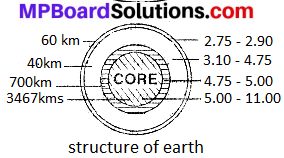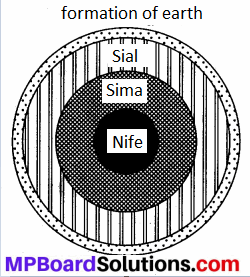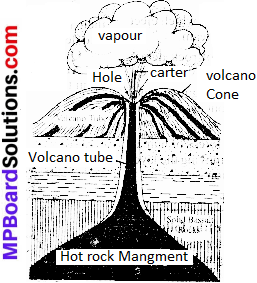MP Board Class 8th Social Science Solutions Chapter 6 Lithosphere and Land Forms
MP Board Class 8th Social Science Chapter 6 Text Book Exercise
Choose the correct option of the following.
MP Board Class 8 Social Science Solution Chapter 6 Question 1.
How much area of earth is covered by hydrosphere?
(a) 61 percent
(b) 71 percent
(c) 81 percent
(d) 51 percent
Answer:
(b) 71 percent
MP Board Class 8 Social Science Chapter 6 Question 2.
Which country is world renowned for earthquakes?
(a) India
(b) France
(c) Japan
(d) Srilanka
Answer:
(c) Japan
Fill up the blanks:
- ………….. area or earth is surrounded by lithosphere.
- The outer layer of earth is called …………….
- Sal contains silicon and ………… metals mostly.
- At the depth of every 32 meter ………….. Celsius temperature increases.
Answers:
- 29 percent
- lithosphere
- Magnesium
- 1°
MP Board Class 8th Social Science Chapter 6 Very Short Answer Type Questions
Lithosphere And Landforms Class 8 Question 1.
Which are the elementary rocks of the earth?
Answer:
The elementary rocks are Igneous rocks.
Class 8 Social Science Chapter 6 MP Board Question 2.
Write names of three prominent land forms?
Answer:
The three land forms are Mountains, Plateaus, Plains.
Class 8 Social Science Chapter 6 Lithosphere And Landforms Question 3.
What do you call when rocks curve like waves?
Answer:
When rocks curve like waves are called Metamorphic rocks.
MP Board Solution Class 8 Social Science Chapter 6 Question 4.
Where volcanoes are mostly dominant in the world?
Answer:
The volcanoes are mostly dominant near the coastal area of pacific ocean and in the continental regions.
MP Board Class 8th Social Science Chapter 6 Short Answer Type Questions
Social Science Class 8 Chapter 6 Question 1.
What is difference between a fold mountain and a rift mountain?
Answer:
Fold Mountain are formed by the horizontal land movement in earth which causes wave like bends in rocks. Rift mountains are formed by breaking of rocks with pressure and tension of the horizontal land movement which causes few part of land lift and few part go down.
Write Names Of Three Prominent Landforms Question 2.
How Sedimentary rocks are formed?
Answer:
Sedimentary rocks are formed due to the deposits of sediments brought by wind, running water or moving ice.
Class 8 Social Science Chapter 6 Question 3.
What is Volcano? Give two causes of eruption?
Answer:
Volcano is an opening on the earth crust, in the form of lava which emits molten magma, rock pieces, gases and steam on the surface of the earth. The two causes of eruptions are, the break up of radioactive minerals under die bottom of earth and the movement of plates due to eternal heat.
MP Board Class 8 Chapter 6 Question 4.
Mention the merits and demerits of earthquakes?
Answer:
Earth quakes are useful when we get fertile lands, formation of new land areas, valuable minerals come upon the surface and lakes are formed in low-lying areas. Earthquakes brings loss of life, material, devastating floods and few areas go down of land.
MP Board Class 8th Social Science Chapter 6 Long Answer Type Questions
Lithosphere And Landforms Question 1.
What is Rock? Explain the type of Rocks?
Answer:
The earth’s crust is made up of rocks. A rock is a mixture of minerals which forms the earths upper part called crust. These rocks are composed of all types of material which may be hard and resistant substance like granite, marble etc. and of soft and loose substance like salt, sand, mud, chalk etc. The difference between rock and mineral is that the rocks contain in them various types of minerals. Rocks do not have definite chemical composition while minerals have definite chemical properties.
There are three kinds of rocks:
1. Igneous Rock
2. Sedimentary Rock
3. Metamorphic Rock
1. Igneous Rock:
Igneous rocks are formed due to the solidification of molten magma. The high temperature inside the earth causes rock masses to melt. The molten material due to heavy pressure inside tries to come out on the surface or to low pressure areas.
In this process some of its material cools down under the earth surface itself and solidifies in the form of solid rocks. Some of it comes out on tire surface as lava and gas hardened. These solidified rocks are called igneous rocks. Basalt and Granite are the other examples. Basalt is formed above the earth surface and Granite below the earth.
2. Sedimentary Rock:
Sedimentary rocks are formed due to the deposits of sediments brought by wind, running water or moving ice. These deposits or sediments lay down on the floor of the river beds, lakes, sea etc. forming one layer over the other. These layers contain fossils also. Fossils are the remains of animals embedded in the rocks. They are also called stratified rocks. Sandstone, Limestone, Clay, Coal, Gravels etc. are the examples of Sedimentary rocks.
3. Metamorphic Rocks:
When main rocks change in appearance and composition losing their original identity, they are called metamorphic rocks. In other words, when Igneous rocks and Sedimentary rocks change their original form due to intense heat and pressure, they are called metamorphic rocks.
The chemical composition of minerals present in the rocks get transformed into new type minerals. For example Limestone gets transformed into Marble, Sandstone changes into granite. Other examples of metamorphic rocks are slate and gneiss etc.
Class 8th Social Science Chapter 6 Question 2.
Define the formation of earth by Diagram?
Answer:
The structure of earth can be divided into three distinct parts. They are Crust, Mantle, Core.
1. The Crust:
The outer most part of the earth is crust. It is also known as lithosphere. It has thickness of 60 kms. It forms the continents, islands and lands underlying seas and oceans. The outer crust is made of silicates and aluminum and is called SIAL.

2. The Mantle:
The next layer that underlies Sial is Mantle. It has two parts:
- inner silicate layer made of silica and magnesium called SIMAL.
- Transitional layer of mixed metals and silicate: This is about 2900 km in thickness, and is made of solid heavy rocks containing mixture of silicates and other metals. The average density of his layer varies between 45 to 5.5.
3. The Core:
The innermost part of the earth is known as Core it extends beyond the depth of 2900 kilometers. It is made up of heavy meta like iron and nickel generally expressed as Nife. They believed to be source of earth magnetism its thickness is 3467 kms. The temperature inside the earth increases at an average rate of 1°C for 32 meters of depth This is also called bray sphere
Class 8 Chapter 6 Social Science Question 3.
Explain the impact of volcanoes on! human life?
Ans. The volcanoes create formations of various land forms like plains, plateaus, mountain etc. We get valuable minerals from these The Java which spreads forms a fertile land after Sometimes. The dead volcanoe smouth filled with rain water creates lakes. The eruption of volcanoes destroy human lives. Cattles. vegetation, Agricultural land cities.
MP Board Class 8 Science Solution Chapter 6 Question 4.
What is earthquake? Describe the causes of the carthquake?
Answer:
Earthquake is sudden shaking of the earth by sudden tectonic or external movement. The place where earthquake occurs is earthquake epicenter (focus). The place exactly over focus where waves of earthquakes are felt is called carthquake center
The causes of earthquake are as follows:
- Sudden movement within earth.
- The eruption of volcano
- The gases or vapors, formed under the bottom of the earth breaks earth crust to come out and thus earthquake happens.
Lithosphere And Land Forms Question 3.
Mention the following rocks in the table given below?
- Marble
- Coal
- Granite
- limestone
- basalt
- Diamond
Answer:
types of rocks
1. Ligneous Rock: Granite basalt
2. Sedimentary Rock: limestone Coal
3. Metamorphic Rock: Marble Diamond
Project Work.
Question 1.
Draw a diagram of the formation of the earth?
Answer:

Question 2.
Draw a sketch of volcano?
Answer:

Question 3.
Collect samples of granite, coal and sand stone?
Answer:
Do your self.